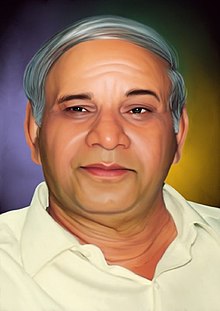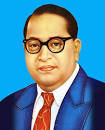![]()
Kanshi Ram (15 March 1934 – 9 October 2006), also known as Bahujan Nayak or Manyavar or Saheb, was an Indian politician and social reformer who worked for the upliftment and political mobilisation of the Bahujans, the backward or lower caste people including untouchable groups at the bottom of the caste system in India. Towards this end, Kanshi Ram founded Dalit Shoshit Samaj Sangharsh Samiti (DS-4), the All India Backward (SC,ST,OBC..) and Minorities Communities Employees’ Federation (BAMCEF) in 1971 and the Bahujan Samaj Party (BSP) in 1984. He ceded leadership of the BSP to his protégé Mayawati who has served four terms as Chief Minister of Uttar Pradesh.

Kanshi Ram was born to a Ramdasia family of Chamar caste on 15 March 1934 in Ropar district, Punjab, British India. Some sources say his birthplace was the village of Pirthipur Bunga and others that it was Khawaspur village.
After studies at various local schools, Ram graduated in 1956 with a BSc degree from Government College Ropar.
Kanshi Ram joined the offices of the Explosive Research and Development Laboratory in Pune under the government’s reservation quota for Schedule caste, Schedule tribe and Other backward castes. It was at this time that he first experienced caste discrimination and in 1964 he became an activist. Those who admire him point out that he was spurred to this after reading B. R. Ambedkar’s book Annihilation of Caste and witnessing the discrimination against a Dalit employee who wished to observe a holiday celebrating Ambedkar’s birth. Kanshi Ram strongly inspired by B. R. Ambedkar and his philosophy.
Ram initially supported the Republican Party of India (RPI) but became disillusioned with its co-operation with the Indian National Congress. In 1971, he founded the All India SC, ST, OBC and Minority Employees Association and in 1978 this became BAMCEF, an organisation that aimed to persuade educated members of the Scheduled Castes, Scheduled Tribes, Other Backwards Classes and Minorities to support Ambedkarite principles. BAMCEF was neither a political nor a religious body and it also had no aims to agitate for its purpose. Suryakant Waghmore says it appealed to “the class among the Dalits that was comparatively well-off, mostly based in urban areas and small towns working as government servants and partially alienated from their untouchable identities”.
Later, in 1981, Ram formed another social organisation known as Dalit Shoshit Samaj Sangharsh Samiti (DSSSS, or DS4). He started his attempt of consolidating the Dalit vote and in 1984 he founded the Bahujan Samaj Party (BSP). He fought his first election in 1984 from Janjgir-Champa seat in Chhattisgarh. The BSP found success in Uttar Pradesh, initially struggled to bridge the divide between Dalits and Other Backward Classes but later under leadership of Mayawati bridged this gap.
In 1982 he wrote his book The Chamcha Age, in which he used the term chamcha (stooge) to describe Dalit leaders such as Jagjivan Ram and Ram Vilas Paswan. He argued that Dalits should work politically for their own ends rather than compromise by working with other parties.
After forming BSP Ram said the party would fight first election to lose, next to get noticed and the third election to win. In 1988 he contested Allahabad seat up against a future Prime Minister V. P. Singh and performed impressively but lost polling close to 70,000 votes.
He unsuccessfully contested from East Delhi (Lok Sabha constituency) (against HKL Bhagat) and Amethi (Lok Sabha constituency) (against Rajiv Gandhi) in 1989 and came in the third position on both the seats. Then he represented the 11th Lok Sabha (1996-1998) from Hoshiarpur, Kanshiram was also elected as member of Lok Sabha from Etawah in Uttar Pradesh.
After Demolition of the Babri Masjid in 1992, Mulayam Singh Yadav and Kanshi Ram joined hands to keep communal forces out of power by creating unity among the backward and Dalit castes and giving the popular slogan “Mile Mulayam-Kanshi Ram, Hawa mein ud gaye Jai Shri Ram”After the election, a coalition government of Samajwadi Party and Bahujan Samaj Party was formed in UP under the leadership of Mulayam Singh Yadav, although due to some differences and Mayawati’s ambition, this alliance broke up in June 1995, Mayawati became first time Chief Minister of Uttar Pradesh in support of BJP. In the late 1990s, Ram described the BJP as the most corrupt (mahabrasht) party in India and the Indian National Congress INC, Samajwadi Party and Janata Dal as equally corrupt. In 2001 He declared Mayawati as his successor.
Ram was a diabetic. He suffered a heart attack in 1994, an arterial clot in his brain in 1995, and a paralytic stroke in 2003. He died in New Delhi on 9 October 2006 of a severe heart attack at the age of 72. He had been virtually bed-ridden for more than two years. According to his wishes, his funeral rites were performed according to Buddhist tradition, with Mayawati lighting the pyre. His ashes were placed in an urn and kept at Prerna Sthal, where many people paid their respects.
In his condolence message, Indian Prime Minister Manmohan Singh described Ram as “one of the greatest social reformers of our time .. his political ideas and movements had a significant impact on our political evolution … He had a larger understanding of social change and was able to unite various underprivileged sections of our society and provide a political platform where their voices would be heard.” Under Ram’s leadership, the BSP won 14 parliamentary seats in the 1999 parliamentary elections.
Taken from Wikipedia. For more about Kanshi Ram please visit [https://en.wikipedia.org/wiki/Kanshi_Ram]


